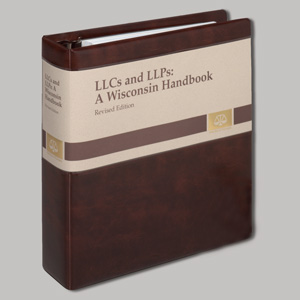March 12, 2025 – Helping your client choose the most appropriate form of doing business is an important task of a business attorney.
In the years preceding the advent of limited liability companies (LLCs) and limited liability partnerships (LLPs), the major developments affecting the choice of business entity were tax related.
However, the universal adoption of the LLC and LLP forms throughout the United States during the 1990s, along with federal approval in 1996 of the “check-the-box” regulations, created an elective approach to tax classification for LLCs, LLPs, and other selected unincorporated entities, meaning that taxes are no longer the major issue.
What are some key factors to consider for your client in choosing between an LLC, a C or S corporation, a general or limited partnership, and an LLP?
Here is some advice in LLCs and LLPs: A Wisconsin Handbook from State Bar of Wisconsin PINNACLE®, supplement chapter 4.36, written by Joseph E. Camilli of von Briesen & Roper, S.C., Milwaukee:
As you may know, LLCs are “entities of contract,” governed to the extent permitted by statute by the internal rules agreed on by their members. With the adoption of the Revised Limited Liability Company Act (RULLCA) by the Wisconsin Legislature under 2021 Wis. Act 258, the existence of those internal rules has undergone a significant shift from prior law.
The RULLCA significantly changes this concept by changing the definition of “operating agreement” and incorporating a formal definition of “written operating agreement.” It does not require that an LLC adopt a written operating agreement but, in the absence of such agreement, Wis. Stat. chapter 183’s rules will apply, see Wis. Stat. § 183.0105, and Wisconsin courts are essentially instructed to impose an operating agreement on the LLC.
LLCs and LLPs: A Wisconsin Handbook: Newly Supplemented

Find out what you need to know in the newly supplemented LLCs and LLPs: A Wisconsin Handbook from State Bar of Wisconsin PINNACLE®. This handbook helps you stay informed on important and popular business entity options and includes detailed discussions on:
You’ll also find thorough analysis of topics including default pass-through treatment under “check-the-box” regulations, the authorization of single-member LLCs, and the rule permitting Wisconsin lawyers to use LLCs and LLPs for their practices. Both the print and Books UnBound versions come with a complete set of fillable forms, including operating, member, and partner agreements.
What's New in 2025
The 2024-25 supplement is current through the 2023-24 Wisconsin statutes; Wisconsin Administrative Register, Dec. 2024, No. 828; United States Public Law No. 118-273 (Jan. 5, 2025); and 90 Federal Register 8104 (Jan. 23, 2025).
The supplement updates URLs, forms, dates, and descriptions, and it includes a 2023 tax court decision that examined whether limited partners can exclude from self-employment income the income that was allocable to the individuals in their capacity as limited partners.
LLCs and LLPs: A Wisconsin Handbook is available in print and via Books UnBound®, PINNACLE’s digital library. Visit WisBar’s Marketplace for more information.
